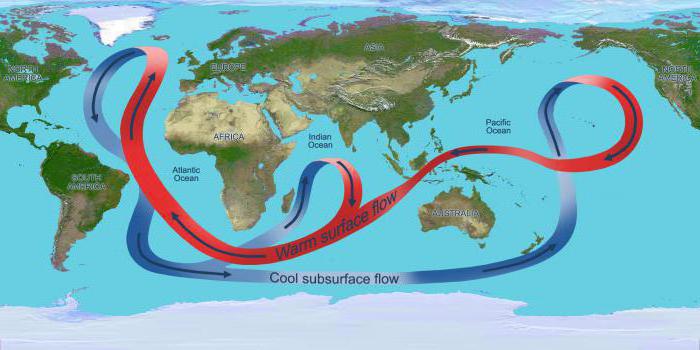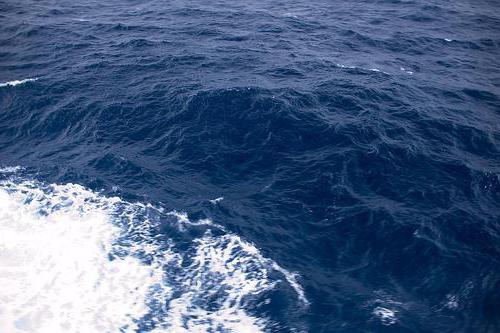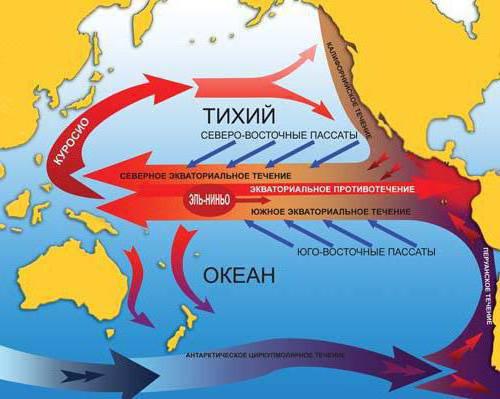The currents of the World Ocean. What is cold and warm current? Description and examples
Oceanic or sea currents - horizontaldisplacement of water masses. As a rule, their movement occurs in a strictly defined direction and can have a large length. The current map, which is located below, displays them in full.
Water flows have significant dimensions: in width they can reach tens, and even hundreds of kilometers, and have a great depth (hundreds of meters). The speed of ocean and sea currents varies - on average, it is 1-3 thousand meters per hour. But, there are also so-called high-speed ones. Their speed can reach 9 000 m / hour.

Where do currents appear?
The causes of water currents may bea sudden change in the temperature of the water due to heating, or, conversely, cooling. They are also affected by different density, for example, in a place where several flows (marine and oceanic) collide, precipitation, evaporation. But basically the cold and warm current is due to the action of winds. Therefore, the direction of the largest oceanic water streams depends mainly on the air currents of the planet.
Flows formed under the influence of winds
Examples of constantly blowing winds are the trade winds. They begin their life from the 30th latitude. The currents created by these air masses are called trade winds. Highlights are the South Passat and the Northern Trade winds. In the temperate zone, similar water currents are formed under the influence of the western winds. They form one of the largest currents of the planet. In the northern and southern hemispheres there are two cycles of the water flow: cyclonal and anticyclonic. Their formation is affected by the inertial force of the Earth.

Varieties of currents
Mixed, neutral, cold and warm current- this is a variety of circulating masses on the planet. When the water temperature of the stream is lower than the temperature of the surrounding water, it is a cold current. If, on the contrary, it is a warm version of it. Neutral currents do not differ from the temperature of the surrounding waters. And mixed can vary on all extent. It is worth noting that there is no constant temperature index of the currents. This figure is very relative. It is determined by comparing the surrounding water masses.
In tropical latitudes, warm currents circulatealong the eastern outskirts of the continents. Cold - along the western. In temperate latitudes, warm currents pass along the western shores, and cold currents along the eastern shores. Identify the variety can be and the other factor. So, there is an easier rule: cold currents go to the equator, and warm - from it.
Value
About it it is necessary to talk in more detail. Cold and warm current plays an important role on planet Earth. The significance of the water circulating masses is that due to their movement, the solar heat is redistributed on the planet. Warm currents increase the temperature of the air in the nearest territories, while cold currents decrease it. Forming on the water, water flows have a serious impact on the mainland. In areas where warm currents are constantly passing, the climate is humid, where the cold - on the contrary, dry. Also, ocean currents contribute to the migration of the ichthyofauna of the oceans. Under their influence, plankton moves, and fish migrate after it.

Examples of warm and cold currents can be cited. Let's start with the first variety. The largest are such water streams: the Gulf Stream, the Norwegian, the North Atlantic, the North and the South Passat, the Brazilian, the Kuroshio, the Madagascar and others. The coldest currents of the oceans: Somalia, Labrador, California.
Large currents
The largest warm current of the planet is the Gulf Stream. It is a meridional circulating stream that carries 75 million tons of water every second. The width of the Gulf Stream is from 70 to 90 km. Thanks to him, Europe gets a comfortable mild climate. From this it follows that the cold and warm current in many respects affects the life of all living organisms on the planet.
From the zonal, cold watercourses, the largestvalue is the flow of Western winds. In the southern hemisphere, near the coast of Antarctica, there are no island or continental clusters. A large portion of the planet is completely filled with water. Here, the Indian, Pacific and Atlantic oceans converge into one stream, merging into a separate huge reservoir. Some scientists recognize its existence and call it Southern. It is here that the largest flow of water is formed - the course of the Western winds. Every second it carries a stream of water, which is three times larger than the Gulf Stream.

Canary Current: warm or cold?
Currents can change their temperature. For example, the flow begins with cold masses. Then it warms up and becomes warm. One of the variants of such a circulating water mass is the Canary Current. It originates in the northeast of the Atlantic Ocean. It is directed by a cold stream along the Iberian peninsula of Europe. Passing along the west coast of Africa, it becomes warm. This passage has long been used by seafarers for travel.
</ p>




